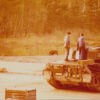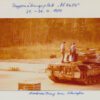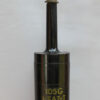Photography Bergen military training area
Inventory number: DPM 9.276.71
An everyday scene at the Bergen military training area in 1980: the crew of a Leopard 1 A1 getting ready for a firing exercise. But it’s not just people and big steel cats that populate the training ground; a wild boar is also gleefully rummaging through the heathland. At first glance, these two scenes don’t seem to go together. But photos like this can often be found in albums of Bundeswehr soldiers’ memories.
Actually, the mere existence of armed forces endangers and in some cases disturbs natural areas. There are areas in Germany that have been used for military purposes for almost 100 years. In addition to heavy metals and chemicals that have leaked into the soil over the decades due to carelessness and a lack of environmental awareness, various dangers also lurk in the form of unexploded ordnance and ammunition remnants. Areas used for military purposes have to be cleared of contaminated sites at great expense before they can be used for civilian purposes and become a genuine nature reserve.
However, military training areas are also refuges for native animal species that have found a refuge in the restricted military area and no longer occur elsewhere in the region.
As numerous studies on former military training areas since the 1990s have shown, there is a great diversity of species on the large, contiguous forest areas that are not influenced by agriculture. Native animal species such as wild boar, red deer, birds, insects and other creatures feel at home on the military training areas. Partridges are accustomed to the regularity of firing exercises, and yellow-bellied toads particularly like to spawn in puddles that form in tank ruts.
In 2016, almost 3,000 km², an area larger than the Saarland, was used as military and military training areas in Germany. In principle, German environmental law is also binding for areas used by the military. However, the military can be granted special rights if compelling reasons for national defense or intergovernmental obligations require this. The Bundeswehr is primarily responsible for implementing and monitoring these measures itself.
For the soldiers practising there, the animals are above all a welcome diversion and are often fed. They lose their shyness and walk in front of the photo lens without a second thought.
Object of the month
(short) stories from the depot
Unfortunately, many objects cannot currently be shown in the exhibition for conservation reasons. Here you will find unusual objects and exciting stories of special pieces from the depot
















